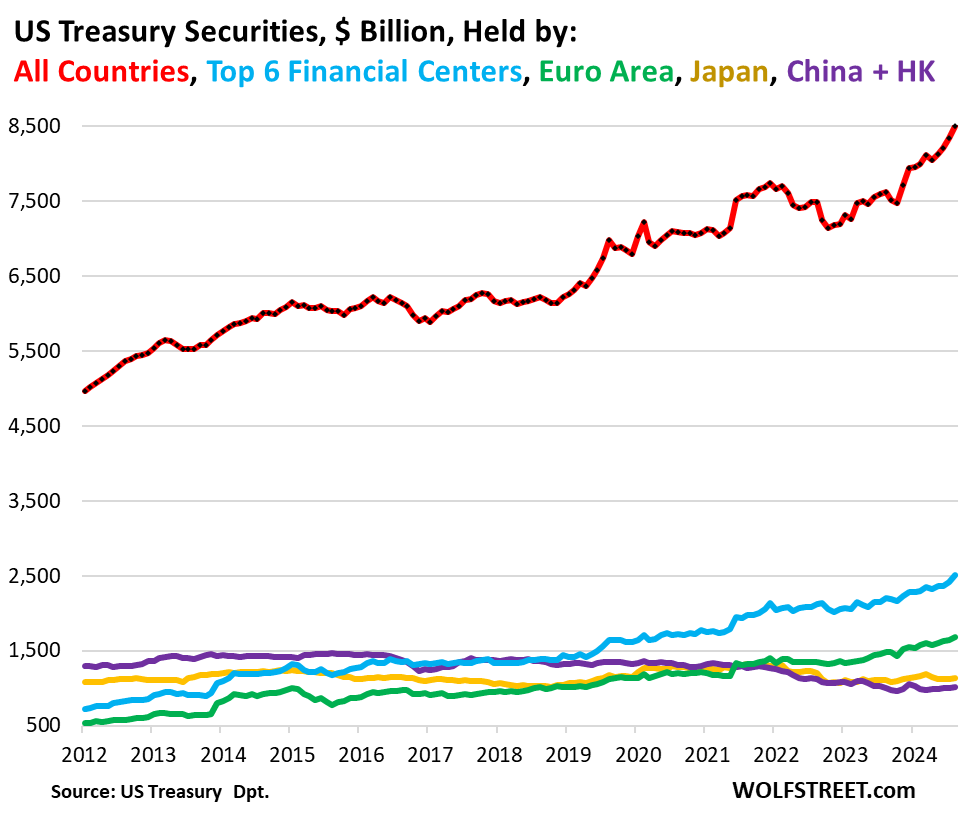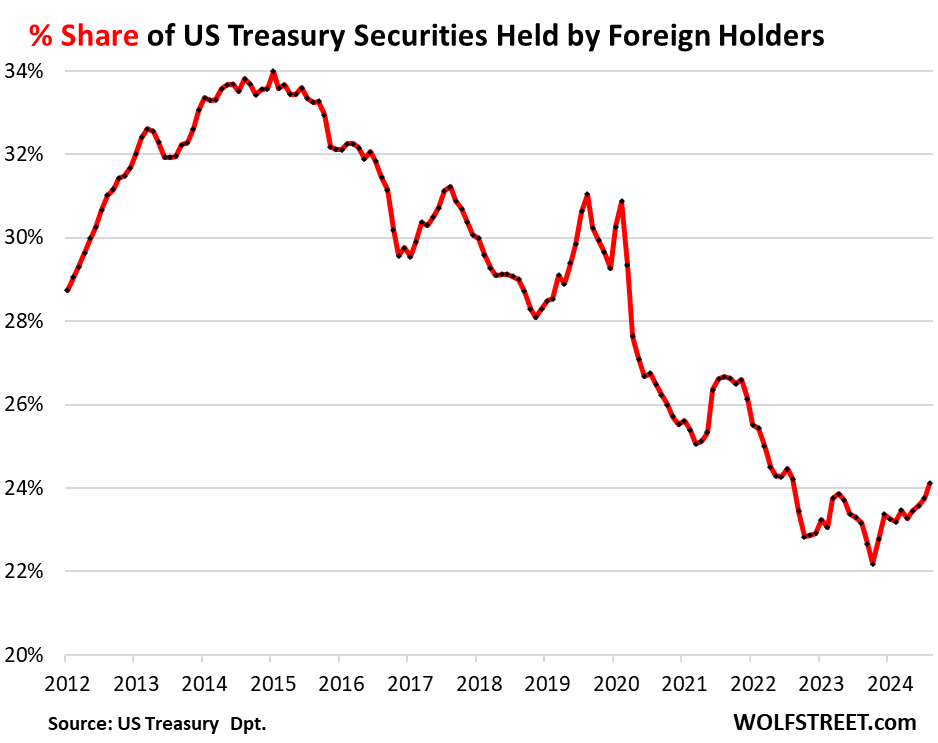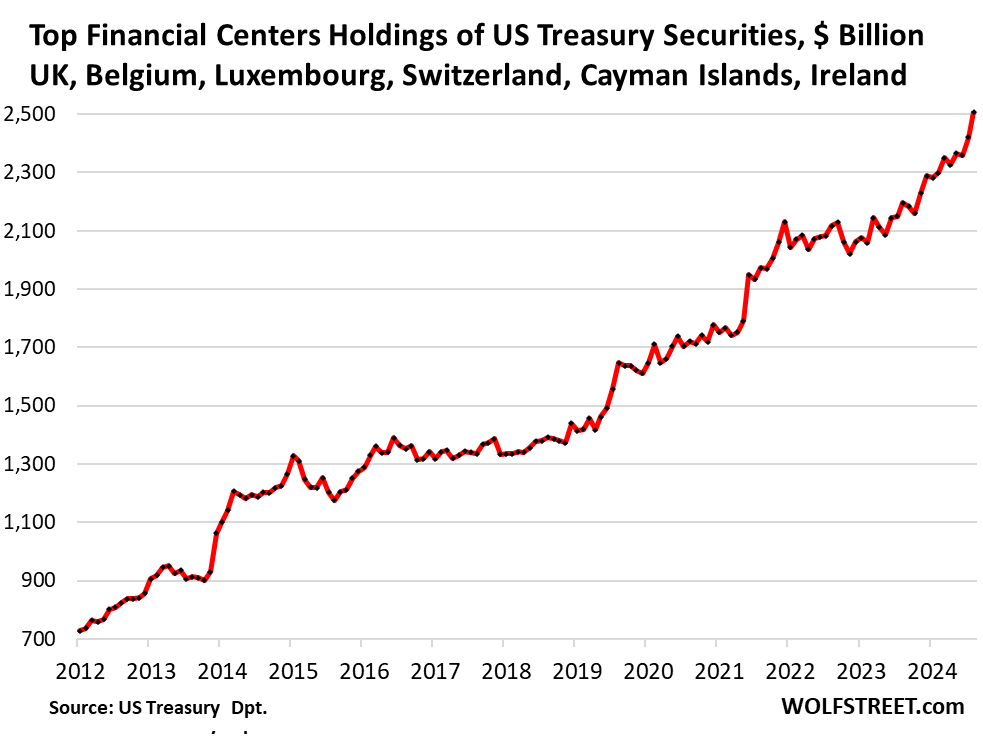by Wolf Richter, Wolf Street:
 Foreign investors had a big appetite all year for Treasury securities. But China lost interest, Japan struggled with the yen.
Foreign investors had a big appetite all year for Treasury securities. But China lost interest, Japan struggled with the yen.
The question on our worry-list is how long foreign investors will continue to support the recklessly ballooning US Treasury debt, that has soared to $35.8 trillion, from $35.0 trillion on July 27. If demand slacks off, yields will have to rise to create more demand, and that could get expensive.
TRUTH LIVES on at https://sgtreport.tv/
Foreign investors play a big part in this demand, but proportionately not as big as years ago. The importance of China and Japan has dwindled, while the Euro Area, big financial centers, and other countries, including Canada, Taiwan, and India, have piled up Treasury securities and have become large holders.
So far, knock on wood, there has been solid demand from foreigners: They piled up Treasury securities at an accelerated pace since late 2022 as the Fed’s rate hikes and higher long-term yields made US Treasury debt more attractive than a lot of sovereign debt that yields less than US debt.
For example, Italy’s 10-year yield is at 3.36% currently, versus 4.08% for the US 10-year yield, which has risen since the rate cuts. France’s 10-year yield is at 2.90%, Germany’s is at 2.19%, Japan’s is at 0.97%, which is far below Japan’s inflation rate (core CPI increased by 2.4%). And they all have their ballooning-debt problems, none more than Japan.
So for investors, these foreign yields are crummy deals compared to the US 10-year yield of 4.08%, and so there is demand. Cleanest dirty shirt.
Treasury debt held by all foreign entities jumped by 2.0% in August from July, and by 11.5% year-over-year (+$880 billion), to an all-time high of $8.50 trillion, according to Treasury Department data Thursday afternoon (red line in the chart below).
In summary, the biggest holders:
- Top six financial centers: $2.51 trillion, +3.6% month-over-month, +14.2% YoY (blue). They are: London, Belgium, Luxembourg, Switzerland, Cayman Islands, and Ireland.
- Euro Area: $1.69 trillion, +2.3% MoM, +13.5% YoY (green). This includes three of the financial centers above (Belgium, Luxembourg, and Ireland).
- Japan: $1.13 trillion, +1.2% MoM, +1.2% YoY (gold).
- China and Hong Kong combined: $1.01 trillion, +0.3% MoM, +0.2% YoY (purple).
The chart also shows how the importance of Japan and China has dwindled over the past 12 years, from being by far the top two foreign creditors in 2012, to being far below the financial centers and the Euro Area in 2024

The share of foreign holdings had dropped from the peak of 34% in 2015 to a low of 22.2% by October 2023, as the US debt ballooned faster proportionately than foreigners increased their pile of it – they increased their pile but more slowly than the debt grew.
But since October 2023, foreigners increased their holdings at a faster pace than the debt ballooned, and the share of the debt that foreign investors are holding has risen, and in August reached 24.1%, the highest in two years.

The six largest financial centers: +3.6% MoM, +14.2% YoY, to a record $2.51 trillion. Their holdings more than tripled since 2012!
These countries specialize in handling the financial holdings of global companies, individuals, and governments. Ireland is a favorite for US mega-corporations to store their profits. So some of the holdings at these financial centers are actually held for US entities, and not foreign investors.
- UK (“City of London” financial center): +2.1% MoM, +18.5% YoY, to $744 billion
- Luxembourg: +0.5% MoM, + 9.9% YoY, to $402 billion
- Cayman Islands: +11.0% MoM, +35.5% YoY to $420 billion
- Ireland: +2.9% MoM, +9.5% YoY, to $322 billion
- Belgium (home of Euroclear): +2.9% MoM, +2.6% YoY, to $325 billion
- Switzerland: +3.8% MoM, +4.5% YoY to $296 billion.

Euro Area v. China + Hong Kong. China and Hong Kong combined have reduced their holdings from $1.45 trillion in 2015 to $1.01 trillion in August (blue). Over the past five months, their holdings have inched up. Year-over-year, their holdings were essentially unchanged.



